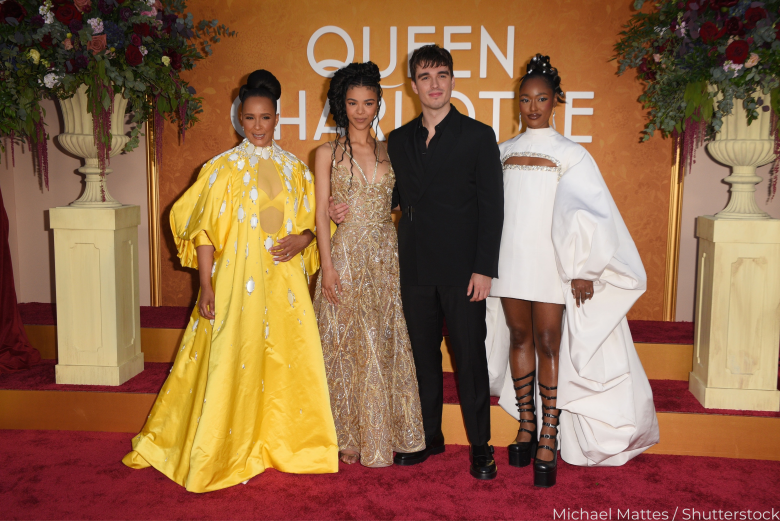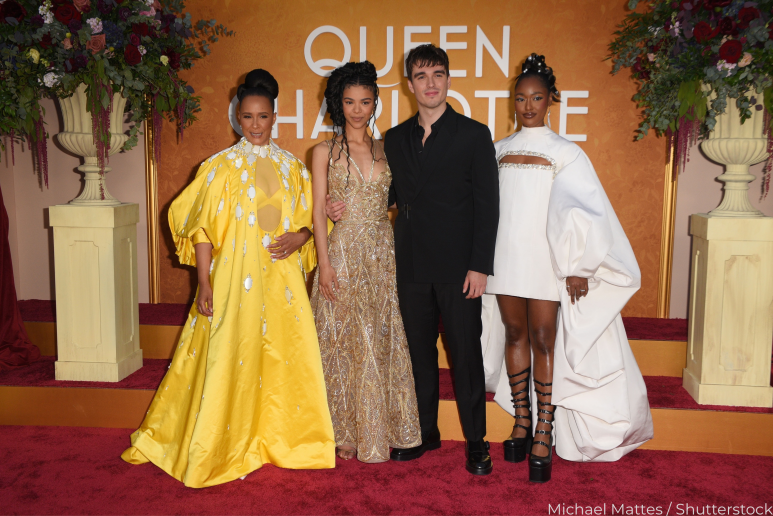By Angelo Boccato
Queen Charlotte: A Bridgerton Story, the spinoff of the Netflix series Bridgerton, was released globally on May 4th, coincidentally around the weekend of King Charles III’s coronation.
While this window of release may not have received much attention, it is telling in terms of the contrast between the historical-fictional royal family portrayed in the former and the living royal family of today.

The series, which is set in 1817, the year when Princess Charlotte married King George III, presents a fictional reality where the presence of a queen of African descent leads the members of high society of African and Asian descent to reach the same status of their white counterparts.
In addition to this, the spinoff manages to remedy an issue around the original series, where the Observer’s Carolyn Hinds pointed out that “the character’s race is almost ignored for most of the show”. In the spin-off, diversity occupies left, front and centre, and the characters of Queen Charlotte and Lady Danbury lead the show.
Actress Adjoa Andoh returns as the mature outspoken version of Lady Danbury, sharing the screen with the younger version of the character played by actress Arsema Thomas, and, similarly, Golda Roushevel, who plays the titular Queen Charlotte shares the screen with younger actress India Armateifio (Doctor Who, Sex Education).
While history has not been actually rewritten, the show, even more than the original series, changes the canon around British period drama, a canon which is generally populated by the never resting ghosts of the country’s history of colonialism.
British period drama as a canon
British TV shows have reached out to very diverse corners in recent decades, from original takes to the superhero genre in Misfits, to raw portrayals of youth in Skins, but one of the traditional and main exports in British television remains the period drama.
From the Georgian era setting of Poldark, to the one of interwar Britain of Downton Abbey to the ones of late Queen Elizabeth II’s life portrayed in Netflix’s The Crown it could be said that period drama is the essence of British TV.
The problematic element around this export, however, is the fact that it paints an image of a society where people of colour are mere extras, if present at all. Even the acclaimed The Crown’s depictions of colonialism do not go beyond enthusiastically Union Jack flags waving masses, or debatable portrayals of Ghanaian Prime Minister Kwame Nkrumah.
Recent British history also plays a central role in this kind of narrative.
In 2016, Igiaba Scego, Italian writer of Somali descent and author of the upcoming period novel set between the 1800s US, UK, and Italy The Colour Line, observed in a piece in the Italian weekly Internazionale, that the Leave campaign in the UK referendum on EU membership, echoed in a lot of its arguments a certain nostalgic feeling for the Empire.
In addition to this, as Scego also observed, this nostalgia, which offers a striking contrast with the present role of Britain, especially after Brexit, by evoking a past of global domination, has also been enhanced by the production of several TV shows. Although t set in different historical time periods, the shows evoke nonetheless a past of “grandiosity”.
This does not mean that positive TV and movie depictions of the British Empire come only from British productions; for example, British imperial forces famously come to the rescue of the titular protagonist in Indiana Jones and the Temple of Doom, the second instalment of Harrison Ford’s archeologist and adventurer which is now widely known for its cultural insensitivity, to say the least.
When it comes to the British movie industry the list of edulcorated and glorified depictions of the Empire is endless, from David Lean’s classics Lawrence of Arabia and The Bridge on the Kwai River to Joe Wright’s Darkest Hour.
In comparison, the list of critical representations of the Empire’s shameful history is far from endless, but it is possible to list among the best and most notable, the late Richard Attenborough’s Gandhi, Neil Jordan’s Michael Collins, Jim Sheridan’s In the Name of the Father, Steve McQueen’s Hunger and Ken Loach’s The Wind that Shakes the Barley; however, none of these remarkable movies are set in Africa or the Caribbean.
When it comes to TV shows the list may even be shorter. A recent example has been interestingly offered by the Marvel Cinematic Universe, in Ms Marvel’s episode “Time and Again” which depicts the India-Pakistan Partition.
While Queen Charlotte does not offer a critique of the British Empire, its central elements are telling when compared to the history of colonialism and to the present day.
Royal and Real Britain
A comment by actress Adjoa Andoh who, on ITV, labeled the image of the Royal family saluting the public from Buckingham Palace’s balcony as “terribly white” received the most Ofcom complaints of the year so far.
Ofcom decided not to proceed and take the complaints further due to freedom of expression, but the very fact that this comment generated such a wide disagreement should raise a certain level of attention.
The Buckingham Palace balcony picture after the coronation was in fact, indistinguishable from the one of the late Queen Elizabeth II in 1953 through its total lack of diversity; the crucial difference is that British society is far more diverse today compared to the past.
More and more British stars of African and Asian descent have risen in UK television and international cinema, from Michaela Coel to Paapa Essiedu, from Anjana Vasan to Riz Ahmed, from Letitia Wright to Jessica Henwick, but a cultural production that is needed is something even beyond the scope of Queen Charlotte.
That would be an honest, complex series of different period dramas, showing the diversity that has been in Britain since the days of the Roman Empire.

